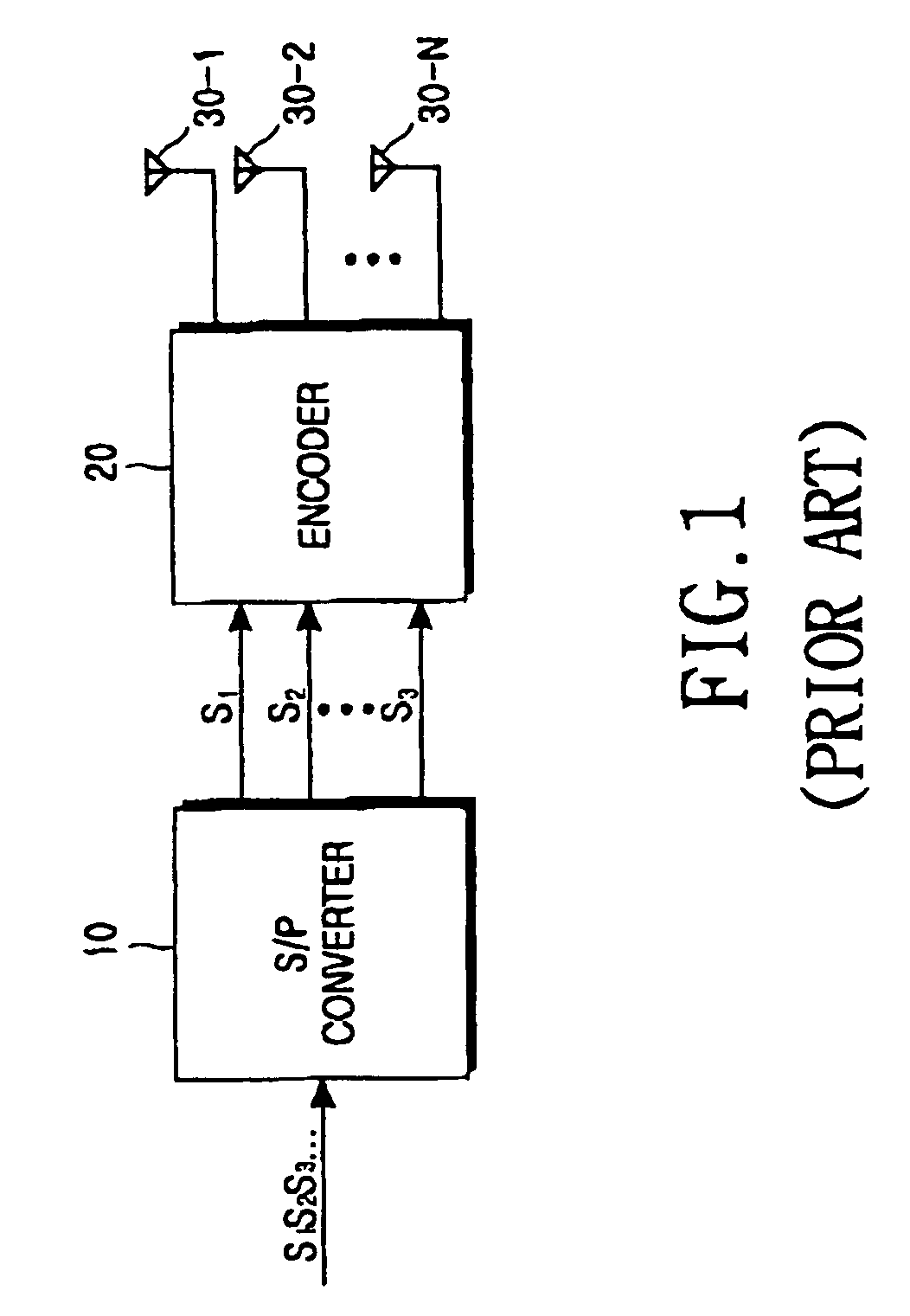Transmitting and receiving apparatus for supporting transmit antenna diversity using space-time block code
a technology of space-time block code and transmit antenna, applied in diversity/multi-antenna system, modulation, electromagnetic wave modulation, etc., can solve the problem that the decoding complexity increases exponentially with the transmission rate, and the transmitter is almost impossible to have perfect instantaneous information about the characteristics of the receiver, etc. problem, to achieve the effect of maximum diversity gain and maximum transmission ra
- Summary
- Abstract
- Description
- Claims
- Application Information
AI Technical Summary
Benefits of technology
Problems solved by technology
Method used
Image
Examples
first embodiment
Decoding
[0094]FIG. 5 is a block diagram of a receiver that decodes according to an embodiment of the present invention. The receiver is comprised of two independent decoders 340 and 345.
[0095]Referring to FIG. 5, a channel estimator 320 estimates channel coefficients representing channel gains from a plurality of transmit antennas to a plurality of receive antennas 310. A symbol arranger 330 collects symbols received from the receive antennas 310 for the four time periods corresponding to transmission by the transmitter illustrated in FIG. 3 or FIG. 4 of one block of symbols at four times.
[0096]The symbol arranger 330 forms a matrix out of the collected symbols. In the matrix, symbols received from the same receive antenna are arranged in the same row and symbols received at the same time are arranged in the same column. Although the plurality of receive antennas 310 are illustrated, decoding for the case of one antenna will be described below, for notational simplicity.
[0097]If fou...
second embodiment
Decoding
[0127]For ML decoding according to the first embodiment, the metric values of all possible symbol pairs must be computed to detect desired symbols. Thus, 8×8 metric calculations are required for 8PSK, and 16×16 metric calculations for 16QAM. These codes can be decoded very quickly by reducing the number of required computations utilizing the characteristics of PSK and QAM.
[0128]FIGS. 6A, 6B and 6C illustrate BPSK, QPSK, and 8PSK signal constellations, respectively. As shown, all PSK modulation symbols lie on a unit circle, which implies that their length is always 1.
[0129]For U6, since x1 and x3 both have length 1, as shown in equation (42), minimizing the metric (35) is equivalent to minimizing
|R1−x1|2+|R3−x3|2+|x1R13−x3|2 (42)
[0130]For each fixed x1, as shown in equation (43), minimizing the sum of equation (42) is equivalent to minimizing
|(R3+x1R13)−x3|2 (43)
[0131]Since x1 is fixed, minimizing the metric of equation (43) is equivalent to finding the closest constellatio...
third embodiment
Decoding
[0147]QPSK or 8PSK symbols can be decoded with a reduced volume of computations despite a lower symbol detection performance, as compared to decoding methods according to the first and second embodiments.
[0148]For 8PSK symbols, the receiver computes the parameters R1, R3 and R13 and finds the closest constellation points q1 to R1, q3 to R3, and q13 to R13. If q13=q1*q3, the receiver outputs q1 and q3.
[0149]If not, the receiver computes an angle Φd by dividing the angle between ql3 and q1*q3 by 2. Then the receiver searches for desired first and second symbols by calculating the ML decoding metric values of first symbol and second symbol candidates whose angles are respectively within the angular distance Φd from q1 and q3.
[0150]Similarly, the receiver computes the parameters R2, R4 and R24 and finds the closest constellation points q2 to R2, q4 to R4, and q24 to R24. If q24=q2*q4, the receiver outputs q2 and q4.
[0151]If not, the receiver computes an angle Φd′ by dividing the...
PUM
 Login to View More
Login to View More Abstract
Description
Claims
Application Information
 Login to View More
Login to View More - R&D
- Intellectual Property
- Life Sciences
- Materials
- Tech Scout
- Unparalleled Data Quality
- Higher Quality Content
- 60% Fewer Hallucinations
Browse by: Latest US Patents, China's latest patents, Technical Efficacy Thesaurus, Application Domain, Technology Topic, Popular Technical Reports.
© 2025 PatSnap. All rights reserved.Legal|Privacy policy|Modern Slavery Act Transparency Statement|Sitemap|About US| Contact US: help@patsnap.com



